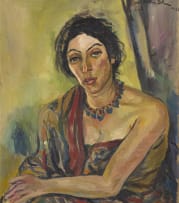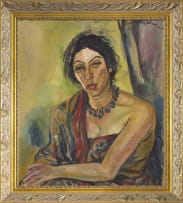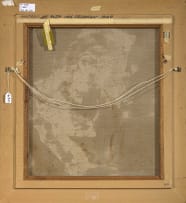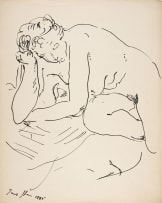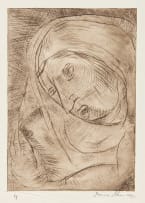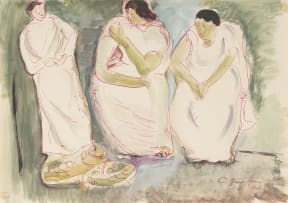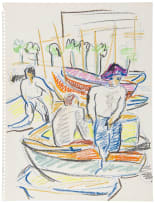Portrait of a Woman in a Sari: Roza
Irma Stern
About the SessionIncl. Buyer's Premium & VAT
About this Item
signed and dated 1929; inscribed with the title, the date and the accession number on the reverse
Notes
Roza van Gelderen (1890-1976) was an important and early promoter of Stern, as well as a lifelong friend. A prominent educationalist and cultural figure, her biography provides an insight into the character of Cape Town during the interwar wars, a period central to Stern's ascendancy as an artist. Born into a prestigious Dutch-Jewish family who immigrated to Durban in 1897, Van Gelderen was distantly related to German poet Heinrich Heine. In 1903 she settled with her family in Cape Town and eventually qualified as an educator.
She became the first Jewish principal of a government school in Cape Town, the non-denominational Central Girls' School. Her work drew inspiration from progressive figures like Scotsman A S Neill, a champion of free self-development in education. Following the school's closure, in 1940, Van Gelderen opened a children's art studio known as The Yellow Windows Studio. A freethinker, her circle included leftists, feminists and émigrés, many of them Jewish, notably the Latvian-born trade unionist and suffragette Ray Alexander Simons. Van Gelderen, who is here depicted wearing a sari, understood the power of dress. She occasionally cropped her hair short and wore men's suits in the style of British author and well-known lesbian Radclyffe Hall.1
Unusually for the time, she was involved in an openly same-sex relationship with teacher and journalist Hilda Purwitsky (1901-98). The couple shared a bungalow in Bakoven. Together they organised a night school for Jewish immigrants as well as headed up a film society that imported and showed chiefly European films. They also wrote numerous press articles together, among them a news report on a 1925 heavyweight boxing match and an account of a 1933 visit to Vienna where they entered a Nazi store, bought two postcards of Hitler, and promptly tore them up in front of the shopkeeper. They were also great champions of contemporary artists like Moses Kottler, Wolf Kibel and Stern. A collector in her own right, Van Gelderen in 1935 donated Stern's large oil Swazi Girls (1931) to the South African National Gallery.
Stern reciprocated the friendship by supporting Van Gelderen's school. She illustrated a 1932 anthology of poetry and prose by students, and in 1936 produced a mural for the school when it moved to its new address in the suburb of Vredehoek. Van Gelderen was also a frequent visitor to Stern's home, The Firs. The extent and depth of this friendship is recorded in Stern's numerous portraits of Van Gelderen. Amply descriptive and often warm hearted, the portraits reveal none of the complexity that sometimes strained their friendship, an animus hinted at in Stern's sniping letters to her friend Freda Feldman. Of the four works depicting Van Gelderen in the Irma Stern Trust Collection, this youthful portrait captures the enigmatic singularity of
"Miss Roza" (as she was known to many) in her prime.
The portrait is notable not only for who it depicts, a progressive woman who extended the cultural horizons of a parochial city, but also how Stern chose to portray her subject. Starting in the late 1920s, Stern became increasingly interested in "colour theory" and devotedher time to "studying and building up
a new palette."2 Stern initially tended to work within a narrow chromatic range, often using earthy tones of green, orange, sienna and brown. Yellow was a marginal colour on Stern's 1920s palette, but would become more integrated into her compositions over the next decade. Here the colour functions almost as an aura around the sitter. Equally notable are the lush tonalities Stern uses to describe Van Gelderen's face and exposed body, as well as the brushwork she uses to evoke the patterning of her sari.
This work gestures to realistic presentation of Stern's stately middle period, inaugurated in the early 1930s with her portraits of Malay brides. Van Gelderen remained loyal to Stern until
the end. She was listed among the mourners at Stern's cremation service at Maitland Cemetery in 1966.
1. Veronica-Sue Belling (2013) Recovering the Lives of South African Jewish Women During the Migration Years, c. 1880-139, unpublished doctoral thesis, University of Cape Town, page 218.
2. Irma Stern (1933) 'Irma Stern and her Work,' South African Life and the Woman's Forum, 7 December: http://www.irmasterntrust.org.za/view.asp?pg=biography
Provenance
The Irma Stern Trust Collection, accession number 630.
Exhibited
Johannes Stegmann Art Gallery, Bloemfontein, Irma Stern, Early Works (1908-1939), 27 January to 26 February 1993, illustrated in the exhibition catalogue in black and white on page viii.
Literature
Neville Dubow (1991) Paradise, The Journal and Letters (1917-1933) of Irma Stern, Cape Town: Chameleon Press, illustrated in black and white on page 94.
Marion Arnold (1995) Irma Stern: A Feast for the Eye, Cape Town: Fernwood Press for Rembrandt Van Rijn Art Foundation, illustrated in a colour photograph of Irma Stern's studio on page 8.

